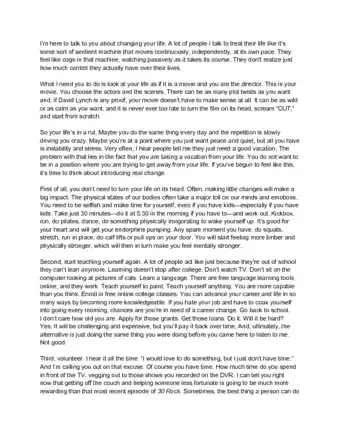This article was co-authored by Deb DiSandro. Deb DiSandro is the Owner of Speak Up On Purpose, an organization dedicated to improving and teaching public speaking. Deb has over 30 years of experience as a national speaker and has presented at the Erma Bombeck Writer’s Conference and the National Society of Newspaper Columnists. She was awarded the National Speakers Association Member of the Year 2007 and has been published in Writer's Digest, Daily Herald, Women's Day, and Better Homes & Gardens.
There are 17 references cited in this article, which can be found at the bottom of the page.
wikiHow marks an article as reader-approved once it receives enough positive feedback. This article received 28 testimonials and 91% of readers who voted found it helpful, earning it our reader-approved status.
This article has been viewed 1,136,334 times.
Being asked to prepare and give a speech can seem really intimidating when you've never done it before. Don't worry! You'll be a public speaking pro in no time if you follow these simple tips.
Steps
Planning Your Speech
-
1Identify the topic of your speech. Choose a single focused message rather than trying to cover multiple topics. Like the thesis of an essay, what you say should connect to your main point.[1]
-
2Pinpoint your audience. Are you speaking to children or adults? Are you speaking to people who know nothing about your topic or people who are experts on your topic? Understanding your audience will help you to target your speech appropriately.[2]Advertisement
-
3Consider your motives. A good speech answers a need that the audience has. Are you trying to make your audience laugh? Are you trying to build their morale, or are you communicating a sober and direct message so that you can change their behavior? These questions will set the mood and tone of your speech.
-
4Think about the setting. Is this a speech for a small group or a speech to deliver before a large audience? You may have more opportunities to interact with a smaller audience so you can add in time for things like questions. With a larger audience, you may need to stick to a firmer structure.[3]
- You may even be able to redirect or add points to your speech with a smaller audience if you notice a number of them are interested in a particular subject or niche.
Writing the Speech
-
1Write a succinct, single-sentence statement about your subject. Try to write something that will hook your audience so that you immediately grab their attention.[4]
- Try starting the speech writing process by free-writing. Write as much as you can about your subject as fast as you can. Don't worry about judgment or crafting perfect sentences. Once you have your points on paper, you can start refining them and putting them in order.
- Use an anecdote or a quote. Sometimes, someone else has already said it better than you ever will. A quote, provided it hasn't been overused, can help you get things started. Just be sure to look for a quote that is surprising or unique, and always credit your source.[5]
- Be cautious about opening with a joke unless you know your audience well. You may think that a joke is funny, but your audience may find it humorless or even offensive.
-
2Choose 3 to 5 supporting points for your topic. Make sure that your points are concise and direct.
- You can start by looking at generic sources like an encyclopedia or Wikipedia, but you need to fact check your ideas with more authoritative sources after you generally understand your subject.
- Draw on your own experience. If you have a long history with your topic, your experiences and personal stories can be great resources. Just keep these stories succinct so that you don't ramble and lose the audience's attention.
-
3Choose how to keep your speech on point. Decide whether you want to write out your speech or to outline the speech on index cards.[6]
- Consider your comfort level with the topic. If you know the topic well and can improvise easily, then use index cards.
- Use 1 card for the introduction. This card should include your opening statement.
- Use 1 or 2 cards for each supporting point. Then, create 1 card for the conclusion which ties back to the main idea of your speech.
- Write brief sentence fragments or even single words on your cards. These words or fragments should contain key phrases that remind you of what you want to say.
- If you feel insecure or don't know the subject well, write out the words of your speech exactly as you want to say them.
- Consider your comfort level with the topic. If you know the topic well and can improvise easily, then use index cards.
-
4Decide whether you want to use visual aids. The choice to use visual aids will depend on the size of your audience and the length of your speech. A long speech, for example, may be easier to sit through with some visuals to break it up. You may create a Prezi or a PowerPoint presentation to go along with your speech, or you may choose to use paper-based charts and graphs.[7]
- Keep the visuals to a minimum. You want them to aid your speech, not to overshadow it. Always make sure your speech can stand on its own should technical problems occur.
- Make sure that the audience can read the content of your visuals. Too big is better than not big enough.
- Check the facilities of the room in which you will be speaking. If you need Internet or you need a projection screen, be sure that the facility has the equipment. Arrive to the room early to make sure everything is functional for your speech.
-
5Prepare handouts, if your subject is detailed and technical. That way, you can cover the most important points in your speech while giving the audience a reference for the more detailed points that they can keep for later.
-
6Write a brief biographical introduction about yourself. Providing your credentials before your speech can help you set your tone, and give you the chance to list your credentials without bragging. Use this to let the audience get an assessment of who you are, and take the moment to introduce not only your background but your style of speaking.[8]
- If someone will be introducing you before your speech, then providing this introduction beforehand will be helpful.
Practicing Your Speech
-
1Set a timer. You should know how long your speech needs to be. If you can't deliver the speech within the given amount of time, then you may need to shorten it or lengthen it. Remember to include time for a Q&A period if appropriate.
-
2Practice your speech in front of a friend or a mirror. Practice looking up at your audience so that your eyes aren't always on your notes. Be sure to include your visual aids in your practice to make sure they are smooth.[9]
- If you drive a regular commute, you can also practice a memorized speech while driving. Don't look off of notecards while on the road, though.
-
3Speak slowly and enunciate clearly. Pause between the sections of your speech so that your audience can digest the information.
-
4Mark up your speech as you go with a pen or pencil. If words sound unnatural to you or a sentence is awkward as you speak it, mark it out and edit it to make it sound natural.
-
5Make a video recording. Record yourself as you make the speech. Analyze your appearance, your body language and your delivery.[10]
- Make sure that your gestures are natural and not too frenetic. Alternatively, don't fix your arms at your sides or keep your hands latched to the podium.
- If you make the speech to a friend or colleague and they offer constructive criticism, try to be open to what they have to say. Make sure they are familiar with your topic or industry, though, or their criticism may do more harm than good.
-
6Practice a few times. If you've delivered your speech in rehearsal multiple times, then you will feel much more confident on stage.[11]
Getting Ready the Day of Your Speech
-
1Dress appropriately. If you need to appear authoritative, choose formal business attire.[12] Choose a color that flatters you and keep bold accessories to a minimum.
-
2Make sure that you have all of your materials in order. Bring your visuals, your tablet or laptop and your speech copy.
-
3Ask for a sound check. If you're in a small room, ask someone to stand at the back of the room and see if he or she can hear you. In a larger facility, practice using the microphone so that your speech is neither too faint nor distorted.
- Try to arrive at your presentation well before your audience. Take the time to make sure the sound is good and run through your visual aids. If you're at a conference, you may have 15-20 minutes to prep. If you're the sole speaker, you could get there an hour in advance.
-
4Set up your equipment and supplementary materials. Make sure that the computer, projection screen and easels are functional and positioned so that they are visible to your audience.
-
5Decide what to do with your handouts. You should either place them on a table for audience members to retrieve or pass them out in an organized fashion.
-
6Ask for a glass of water. If your speech is lengthy, then you will need some water to moisten your throat.
-
7Look in a mirror before you go onstage. Check both the front and the back of your outfit and make sure that your hair is neat and that your makeup, if you're wearing any, is not smudged.
During Your Speech
-
1Look around the audience. Don't focus on only one person or area.[13]
- Make eye contact with members of your audience. If eye contact is too intense for you, look just above their heads at a point such as a clock or a painting. Remember to look to both sides of the room. Don't favor just the right or left.
- Move your eyes around your audience so that everyone feels included in the presentation.
-
2Speak slowly and try to breathe normally. The natural adrenaline rush that you will have in front of your audience may make you want to speak much too quickly. And have a confident smile on your face.
-
3Laugh at yourself if something goes wrong. If by chance, you forget your speech, then simply say thank you and leave the stage. Your audience will find you much more easy to relate to, and you won't lose their confidence in your knowledge of your subject.
- Never leave the stage if something goes wrong, even if you feel embarrassed. Make a joke if you can, shake it off, and move forward.
-
4Give your audience a chance to interact with you. Ask questions. As well have them ask you questions, so you can touch up on some points that you overlooked and/or left out,)before leaving the podium at the end of your speech. Acknowledge your audience with a smile, a brief nod or a slight bow, if appropriate.[14]
- Be sure to build time for any Q and A into your allotted presentation time. That way, you can control the flow of the Q and A. Then, after the last question, let your audience know, "I'd like to share one final thought with you," and deliver a powerful closer.
Samples of Persuasive Speeches
Samples of Informational Speeches
Community Q&A
-
QuestionHow do I manage my body language while speaking?
 Community AnswerStand tall and straight and, if possible, keep both feet on the ground. You can use some body gestures/movements, but not too many. Make eye contact with your audience, but don't focus on a particular person.
Community AnswerStand tall and straight and, if possible, keep both feet on the ground. You can use some body gestures/movements, but not too many. Make eye contact with your audience, but don't focus on a particular person. -
QuestionHow can I speak fluently?
 Community AnswerJust before you go on stage, you can try to memorize your speech one more time. If you have problems with stuttering, just take a deep breath and when you feel ready, continue with your speech. Also, as the article said, know what your topic is about. If you forget a part, you can still talk about it and the audience won't even know that you skipped a part.
Community AnswerJust before you go on stage, you can try to memorize your speech one more time. If you have problems with stuttering, just take a deep breath and when you feel ready, continue with your speech. Also, as the article said, know what your topic is about. If you forget a part, you can still talk about it and the audience won't even know that you skipped a part. -
QuestionHow can I thank people after my speech?
 Terrence MacArthurCommunity Answer"Ladies and gentlemen, thank you for your time and attention."
Terrence MacArthurCommunity Answer"Ladies and gentlemen, thank you for your time and attention."
Things You'll Need
- Written speech or index cards
- Friend, teacher or family member for practicing
- Video recording device
- Computer or tablet for presentations
- Charts and easel for presentations
- Microphone for a large room
- Handouts
- Glass of water
- Mirror
- Appropriate outfit
References
- ↑ https://saylordotorg.github.io/text_business-communication-for-success/s14-02-choosing-a-topic.html
- ↑ https://www.apa.org/monitor/2017/02/tips-speaking
- ↑ https://www.comm.pitt.edu/oral-comm-lab/audience-analysis
- ↑ https://www.americanbar.org/groups/litigation/committees/trial-practice/practice/2015/5-tips-for-engaging-opening-statements/
- ↑ https://open.lib.umn.edu/publicspeaking/chapter/9-2-the-attention-getter-the-first-step-of-an-introduction/
- ↑ https://www.comm.pitt.edu/structuring-speech
- ↑ https://www.comm.pitt.edu/visual-aids
- ↑ https://wmich.edu/career/personalcommercial
- ↑ https://www.toastmasters.org/resources/public-speaking-tips/preparing-a-speech
- ↑ https://www.edutopia.org/discussion/record-yourself-improve-your-practice
- ↑ https://www.purdueglobal.edu/blog/student-life/10-public-speaking-tips/
- ↑ https://courses.lumenlearning.com/suny-ccc-spch-1080-1/chapter/chapter-12-nonverbal-aspects-of-delivery/
- ↑ https://www.hamilton.edu/academics/centers/oralcommunication/guides/tips-for-effective-delivery
- ↑ https://www.forbes.com/sites/work-in-progress/2014/01/28/five-easy-tricks-to-make-your-presentation-interactive/#3b01c83d2586
- ↑ https://www.theguardian.com/careers/careers-blog/10-quirky-tips-beating-interview-nerves-job
- How to Write a Great Speech: 5 Secrets for Success
- How to Give a Great Speech
About This Article
To prepare and give a speech, start by thinking about the topic, audience, and location of the speech. Write a detailed outline that includes your main topics, supporting points, and facts. Then, transfer the speech to note cards or handouts if necessary. Remember to practice your speech a few times in front of a mirror or a friend, and set a timer to ensure that you aren’t taking too long. On the day of the speech, review your note cards and make sure your presentation, handouts, or other supplementary information is in order. For tips on keeping calm during the speech and examples of different speeches, read on!

-Step-6.webp)
-Step-10.webp)
-Step-13.webp)

















-Step-5.webp)







































































